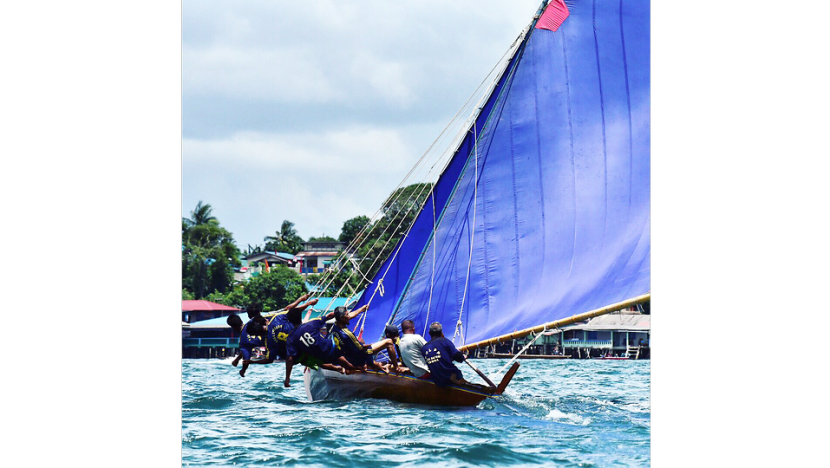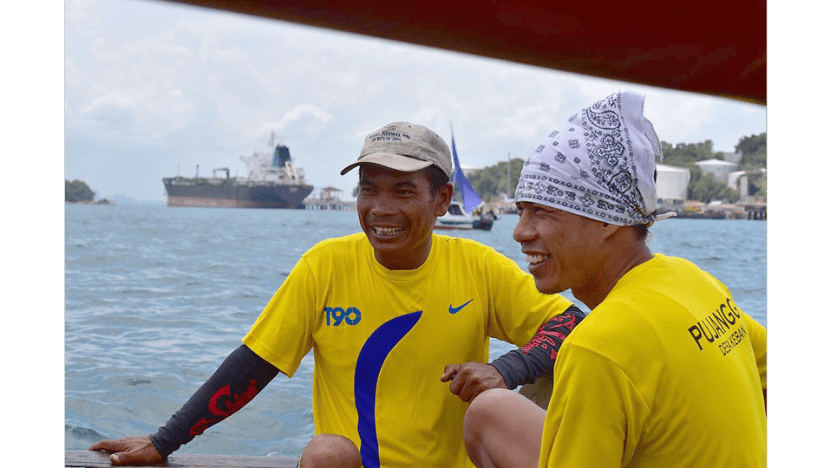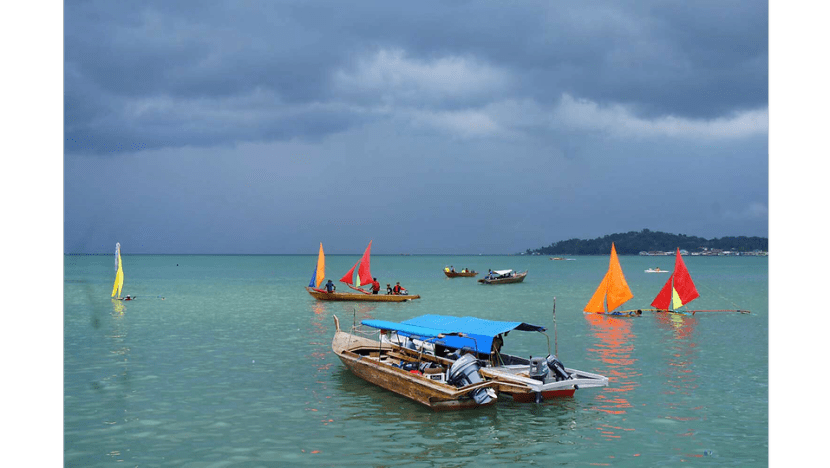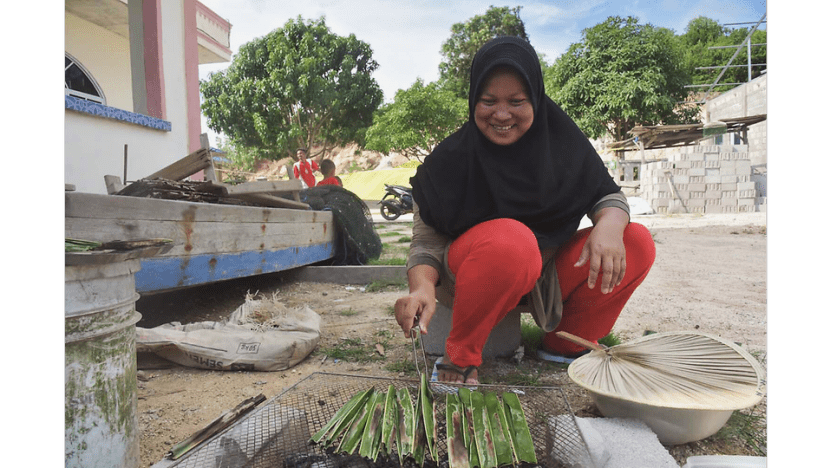A yearning to bring kolek races back to Singapore
The conclusion to the story of a family’s dream of reviving the glory days of traditional Malay sailboat racing - which, for over a century, made waves in Riau-Johor-Singapore waters.

A kolek race off Tanjung Pinang. (Photo: Lam Shushan)
Words by Mayo Martin / Multimedia by Lam Shushan
Read Part 1 of this series: Watching a way of life vanish
Part 2: Bringing back a centuries-old tradition
RIAU ISLANDS, INDONESIA: For some Singapore residents watching at home, it is stirring nostalgic memories of days gone by – and the wistful hope that they might be brought again.
Watching this, Yazid Van Lamri writes: “Last watched this with my late father at the coastal areas of (Pasir) Panjang behind hawker centre now at nearby park.. they call it ‘lumba kolek’.”
Others like Hisham Hiseánas Huang remember how these tall, graceful sailboats that have been part of the region’s maritime culture since the 1800s used to be raced during the New Year Regatta and off Katong, Siglap, Telok Kurau and Bedok.

Arthur Lee says: “If this was part of our Singaporean history, why not have Singapore Tourism Board organise this event? I believe it could start from Clifford Pier, go around Sentosa as a tourist promotional event, and end at HarbourFront.”
Baseer Shamsudin is among those who thinks it a good idea to revive such community-bonding activities. In the old days, kolek racing was a kampung-versus-kampung event, much like neighbourhood football clubs.
Watch: The Facebook Live stream from Tanjung Pinang
It’s all very encouraging for Mazlan Mohd Nasir, a Singaporean who is working to bring back the sport of kolek racing to prominence again, at least in the Riau Islands. (Read about his efforts here.)
“It feels great having these positive responses. When there are more participants, things can become a reality,” says the 54-year-old, who grew up in the Southern Islands watching his family’s kolek, Pujangga, catch the breeze. (More on the old days here.)
LIKE WRESTLING A BULL ON WATER
The thrill of these races isn’t like Formula 1 or horse racing, where the competitors burst full-throttle from the starting blocks. But there’s a certain elegance when their brightly-coloured huge sails slowly spread as the crews labour to harness the wind.
And then they suddenly power past you, and you realise how fast these craft are. Mazlan says they can potentially go up to 11 knots (20kph) tapping sheer wind power.

And because they always seem to be tilted to the side, kolek give the impression of perpetually being this close to capsizing. Straining to control the sails, the crew stand on the gunwale at a perpendicular angle to the boat in order to maintain balance. Inside, there’s always one man frantically bailing out the water coming in.
Forget F1, this looks more like a rodeo - with nine people valiantly trying to subdue a very stubborn and gigantic bull.
There’s a little sense of awe when you realise just how much skill it takes - and pride, too, when you remember that the kolek of the Riau-Singapore-Johor region in the 1800s was way ahead of the English sailboat (which used to be beaten by the kolek in races in the 1960s, Mazlan recalls).
In fact the trapeze method of leaning out of the boat, it is said, only came to be used by English sailors in the 1930s.
Watch: The kolek in action. Watch from 3:05 for how the traditional compares to the modern sailboat.
What’s at stake at these races? Mazlan says there are trophies and a bit of cash, around S$80 at most for the winning team. But more importantly, it’s about “the name (of the boat) and the pride”.
AGAINST THE STORM
Unfortunately, this isn’t Mazlan’s racing season. His family’s boat capsizes twice in two races in August, which is when we first witness Pujangga in action in the Riau islands.
When its yellow sail vanishes from view for the second consecutive race, it’s not alone – eight of the 11 boats in its category also capsized, a testimony to how tough this sport is. “The wind is very strong over there,” mutters Mazlan.

The drenched sailors come up to collect their consolation prize of packets of nasi padang, water and fuel for the ride back home. “Capsize again!” one of the sailors blurts out. They’re all smiles, but Mazlan’s nephew Firhan whispers to us: “They’ll be upset.”
It’s two months before we see Pujangga again, this time in Tanjung Pinang in October in the biggest and final race to be held this year. The kolek capsizes in its third consecutive race. But this time, Mazlan is beaming.
Not only has Pujangga been joined by another kolek from Keban, where Mazlan’s 76-year-old father lives and the family is trying to revive the racing culture - Mazlan has also finally convinced his wife, who doesn’t share his passion, to leave Singapore for a bit and join him in Bintan for this race.
More than 30 kolek start out on that very tough circuit, circling a large island off Bintan. A fierce squall blows in half an hour into the race. As the rain and winds lash out, the Pujangga is among its many victims.
But for Mazlan, this third consecutive capsize isn’t a bad result at all. Before the storm hit, the kolek was among the frontrunners at some points and had managed to reach the turning point at the other island, the longest distance it had sailed this year.
“I’m satisfied,” he tells us. “They did it against the strong winds, which shows you the quality of the boat and the crew.”

He’ll have to wait till next year for his kolek to finish a race. But for now, as the survivors trickle in to much cheering and good-natured heckling by spectators cheering for their kampong teams, it’s time to enjoy the moment.
ISLANDERS COME FULL CIRCLE
Indeed at the end of the day, winning and losing isn’t the most important thing that matters to these island-folks.
After one of the losses, we return with Mazlan to his father Mohd Nasir Awang's compound in Keban. While we were busy at the race, his sister Lela and the others have been busy preparing for a sumptuous feast serving as both a celebration and a commemoration.

It’s a thank-you dinner for the valiant crew who gave it their all. It is also held in memory of Mazlan and Lela’s mother, Cik Nasir's wife, who passed away in 2003; and their brother, a diver who died in 2008. For them, family and community are one and the same.
The living room has been cleared out to make room for the guests, folks from the villages who pack themselves in to sit on the floor as the village priest leads the prayers.
Afterwards, the food streams out of the kitchen, a buffet of chicken curry, epok-epok, bubur kacang hijau, prawn porridge, roti jala and an assortment of kuehs.
Watch: Food they make at home on Keban (1:20)
As the air grows thick with cigarette smoke, Mazlan, who’s seated with the crew, leans over to us and says: “This is the time for bonding. We get together to talk and share stories.”
Since there is no race the next day, everyone stays up later than usual. After dinner, Mazlan, Cik Nasir and the crew move outside to continue their banter under the stars.

Despite having lived much of their lives in Singapore, it’s clear just how strong these Singaporeans’ bonds are with the people of Keban, who have embraced them in turn.
For Cik Nasir, it’s a life that has come full circle: The son of a penghulu who left Keban to build a family (and even help a new nation find its footing) is now back home.
For his own son, Mazlan, after losing touch with his kampung childhood by the sea and his beloved kolek, he has rediscovered in his father’s hometown. And now he shuttles between two places he calls home, to keep a unique tradition afloat for the next generation.
Read Part 1 and Part 2 of Mazlan’s story. Coming up: A former Singapore national sailor turns artist documenting traditional boats.


















